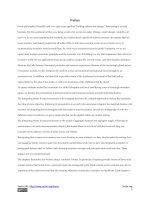Principles of macroeconomics 10e by case fair oster ch06
Bạn đang xem bản rút gọn của tài liệu. Xem và tải ngay bản đầy đủ của tài liệu tại đây (891.59 KB, 56 trang )
PRINCIPLES OF
MACROECONOMICS
PART II Concepts and Problems in Macroeconomics
TENTH
EDITION
CASE FAIR OSTER
© 2012 Pearson Education, Inc. Publishing as Prentice Hall
Prepared by: Fernando Quijano & Shelly
1 ofTefft
56
PART II Concepts and Problems in Macroeconomics
© 2012 Pearson Education, Inc. Publishing as Prentice Hall
2 of 56
Measuring National
Output and National
Income
6
CHAPTER OUTLINE
Gross Domestic Product
Final Goods and Services
Exclusion of Used Goods and Paper Transactions
Exclusion of Output Produced Abroad by Domestically Owned
Factors of Production
PART II Concepts and Problems in Macroeconomics
Calculating GDP
© 2012 Pearson Education, Inc. Publishing as Prentice Hall
The Expenditure Approach
The Income Approach
Nominal versus Real GDP
Calculating Real GDP
Calculating the GDP Deflator
The Problems of Fixed Weights
Limitations of the GDP Concept
GDP and Social Welfare
The Underground Economy
Gross National Income per Capita
Looking Ahead
3 of 56
PART II Concepts and Problems in Macroeconomics
national income and product accounts Data collected
and published by the government describing the various
components of national income and output in the economy.
© 2012 Pearson Education, Inc. Publishing as Prentice Hall
4 of 56
Gross Domestic Product
PART II Concepts and Problems in Macroeconomics
gross domestic product (GDP) The total market value
of all final goods and services produced within a given
period by factors of production located within a country.
GDP is the total market value of a country’s output. It is the market
value of all final goods and services produced within a given period
of time by factors of production located within a country.
© 2012 Pearson Education, Inc. Publishing as Prentice Hall
5 of 56
Gross Domestic Product
Final Goods and Services
final goods and services Goods and services produced for final use.
PART II Concepts and Problems in Macroeconomics
intermediate goods Goods that are produced by one firm for use in
further processing by another firm.
value added The difference between the value of goods as they
leave a stage of production and the cost of the goods as they entered
that stage.
© 2012 Pearson Education, Inc. Publishing as Prentice Hall
6 of 56
PART II Concepts and Problems in Macroeconomics
To arrive at GDP, the Bureau of Economic Analysis (BEA) counts:
a.
The value of total sales, including sales to suppliers and
sales to consumers.
b.
The value of final sales.
c.
The value of intermediate goods and final goods.
d.
Value added plus the value of sales at the retail level.
e.
Any of the above.
© 2012 Pearson Education, Inc. Publishing as Prentice Hall
7 of 56
PART II Concepts and Problems in Macroeconomics
To arrive at GDP, the Bureau of Economic Analysis (BEA) counts:
a.
The value of total sales, including sales to suppliers and
sales to consumers.
b. The value of final sales.
c.
The value of intermediate goods and final goods.
d.
Value added plus the value of sales at the retail level.
e.
Any of the above.
© 2012 Pearson Education, Inc. Publishing as Prentice Hall
8 of 56
Gross Domestic Product
Final Goods and Services
PART II Concepts and Problems in Macroeconomics
In calculating GDP, we can sum up the value added at each
stage of production or we can take the value of final sales.
We do not use the value of total sales in an economy to
measure how much output has been produced.
TABLE 6.1 Value Added in the Production of a Gallon of
Gasoline (Hypothetical Numbers)
Stage of Production
(1)
Oil drilling
(2)
Value of Sales
Value Added
$3.00
$3.00
Refining
3.30
0.30
(3)
Shipping
3.60
0.30
(4)
Retail sale
4.00
0.40
Total value added
© 2012 Pearson Education, Inc. Publishing as Prentice Hall
$4.00
9 of 56
Gross Domestic Product
Exclusion of Used Goods and Paper Transactions
PART II Concepts and Problems in Macroeconomics
GDP is concerned only with new, or current,
production. Old output is not counted in current GDP
because it was already counted when it was produced.
GDP does not count transactions in which money or
goods changes hands but in which no new goods and
services are produced.
© 2012 Pearson Education, Inc. Publishing as Prentice Hall
10 of 56
Gross Domestic Product
Exclusion of Output Produced Abroad by Domestically Owned Factors of
Production
PART II Concepts and Problems in Macroeconomics
GDP is the value of output produced by factors of
production located within a country.
gross national product (GNP) The total market value
of all final goods and services produced within a given
period by factors of production owned by a country’s
citizens, regardless of where the output is produced.
© 2012 Pearson Education, Inc. Publishing as Prentice Hall
11 of 56
PART II Concepts and Problems in Macroeconomics
Which of the following is counted in GDP?
a.
The output produced by U.S. citizens abroad.
b.
The profits earned abroad by U.S. companies.
c.
The output produced by foreigners working in U.S.
companies abroad.
d.
The profits earned in the Unites States by foreign-owned
companies.
© 2012 Pearson Education, Inc. Publishing as Prentice Hall
12 of 56
PART II Concepts and Problems in Macroeconomics
Which of the following is counted in GDP?
a.
The output produced by U.S. citizens abroad.
b.
The profits earned abroad by U.S. companies.
c.
The output produced by foreigners working in U.S.
companies abroad.
d. The profits earned in the Unites States by foreign-owned
companies.
© 2012 Pearson Education, Inc. Publishing as Prentice Hall
13 of 56
Calculating GDP
PART II Concepts and Problems in Macroeconomics
expenditure approach A method of computing
GDP that measures the total amount spent on all
final goods and services during a given period.
income approach A method of computing GDP
that measures the income—wages, rents,
interest, and profits—received by all factors of
production in producing final goods and services.
© 2012 Pearson Education, Inc. Publishing as Prentice Hall
14 of 56
Calculating GDP
The Expenditure Approach
There are four main categories of expenditure:
PART II Concepts and Problems in Macroeconomics
Personal consumption expenditures (C): household
spending on consumer goods
Gross private domestic investment (I): spending by
firms and households on new capital, that is, plant,
equipment, inventory, and new residential structures
Government consumption and gross investment (G)
Net exports (EX − IM): net spending by the rest of
the world, or exports (EX) minus imports (IM)
© 2012 Pearson Education, Inc. Publishing as Prentice Hall
GDP = C + I + G + (EX − IM)
15 of 56
Calculating GDP
The Expenditure Approach
TABLE 6.2 Components of U.S. GDP, 2009: The Expenditure Approach
PART II Concepts and Problems in Macroeconomics
Billions of Dollars
Personal consumption expenditures (C)
Durable goods
Nondurable goods
Services
Gross private domestic investment (l)
Nonresidential
Residential
Change in business inventories
Government consumption and gross
investment (G)
Federal
State and local
Net exports (EX – IM)
Exports (EX)
Imports (IM)
Gross domestic product
10,089.1
Percentage of GDP
70.8
1,035.0
2,220.2
6,833.9
1,628.8
7.3
15.6
47.9
11.4
1,388.8
361.0
−120.9
2,930.7
9.7
2.5
−0.8
20.5
1,144.8
1,786.9
−392.4
8.0
12.5
− 2.8
1,564.2
1,956.6
14,256.3
11.0
13.7
100.0
Note: Numbers may not add exactly because of rounding.
© 2012 Pearson Education, Inc. Publishing as Prentice Hall
16 of 56
PART II Concepts and Problems in Macroeconomics
For the year 2009, the percentages of C, I, G, and (EX – IM) in
U.S. aggregate expenditure were roughly as follows:
a.
71%, 11%, 21%, and –3%.
b.
42%, 18%, 25%, and 15%.
c.
37%, 69%, 7%, and –13%
d.
32%, 27%, 41%, and 0%.
© 2012 Pearson Education, Inc. Publishing as Prentice Hall
17 of 56
PART II Concepts and Problems in Macroeconomics
For the year 2009, the percentages of C, I, G, and (EX – IM) in
U.S. aggregate expenditure were roughly as follows:
a.
71%, 11%, 21%, and –3%.
b.
42%, 18%, 25%, and 15%.
c.
37%, 69%, 7%, and –13%
d.
32%, 27%, 41%, and 0%.
© 2012 Pearson Education, Inc. Publishing as Prentice Hall
18 of 56
Calculating GDP
The Expenditure Approach
Personal Consumption Expenditures (C)
PART II Concepts and Problems in Macroeconomics
personal consumption expenditures (C) Expenditures by
consumers on goods and services.
durable goods Goods that last a relatively long time, such
as cars and household appliances.
nondurable goods Goods that are used up fairly quickly,
such as food and clothing.
services The things we buy that do not involve the
production of physical things, such as legal and medical
services and education.
© 2012 Pearson Education, Inc. Publishing as Prentice Hall
19 of 56
PART II Concepts and Problems in Macroeconomics
The largest component of Personal Consumption Expenditures (C)
is:
a.
Durable goods.
b.
Nondurable goods.
c.
Services.
d.
Residential Investment.
e.
Imports.
© 2012 Pearson Education, Inc. Publishing as Prentice Hall
20 of 56
PART II Concepts and Problems in Macroeconomics
The largest component of Personal Consumption Expenditures (C)
is:
a.
Durable goods.
b.
Nondurable goods.
c.
Services.
d.
Residential Investment.
e.
Imports.
© 2012 Pearson Education, Inc. Publishing as Prentice Hall
21 of 56
E C O N O M I C S I N PRACTI C E
Where Does eBay Get Counted?
PART II Concepts and Problems in Macroeconomics
eBay’s business is to provide a
marketplace for exchange. In doing so,
it uses labor and capital and creates
value.
In return for creating this value, eBay
charges fees to the sellers that use its
site. The value of these fees enter into
GDP.
So while the old knickknacks that
people sell on eBay do not contribute to current GDP, the cost of finding an
interested buyer for those old goods does indeed get counted.
© 2012 Pearson Education, Inc. Publishing as Prentice Hall
22 of 56
Calculating GDP
The Expenditure Approach
Gross Private Domestic Investment (I)
PART II Concepts and Problems in Macroeconomics
gross private domestic investment (I) Total
investment in capital—that is, the purchase of new
housing, plants, equipment, and inventory by the
private (or nongovernment) sector.
nonresidential investment Expenditures by firms
for machines, tools, plants, and so on.
residential investment Expenditures by households
and firms on new houses and apartment buildings.
© 2012 Pearson Education, Inc. Publishing as Prentice Hall
23 of 56
Calculating GDP
The Expenditure Approach
Gross Private Domestic Investment (I)
PART II Concepts and Problems in Macroeconomics
change in business inventories The amount by which
firms’ inventories change during a period. Inventories are
the goods that firms produce now but intend to sell later.
Change in Business Inventories
GDP = Final sales + Change in business inventories
© 2012 Pearson Education, Inc. Publishing as Prentice Hall
24 of 56
Calculating GDP
The Expenditure Approach
Gross Private Domestic Investment (I)
Gross Investment versus Net Investment
PART II Concepts and Problems in Macroeconomics
depreciation The amount by which an asset’s
value falls in a given period.
gross investment The total value of all newly
produced capital goods (plant, equipment, housing,
and inventory) produced in a given period.
net investment Gross investment minus
depreciation.
capitalend of period = capitalbeginning of period + net investment
© 2012 Pearson Education, Inc. Publishing as Prentice Hall
25 of 56









